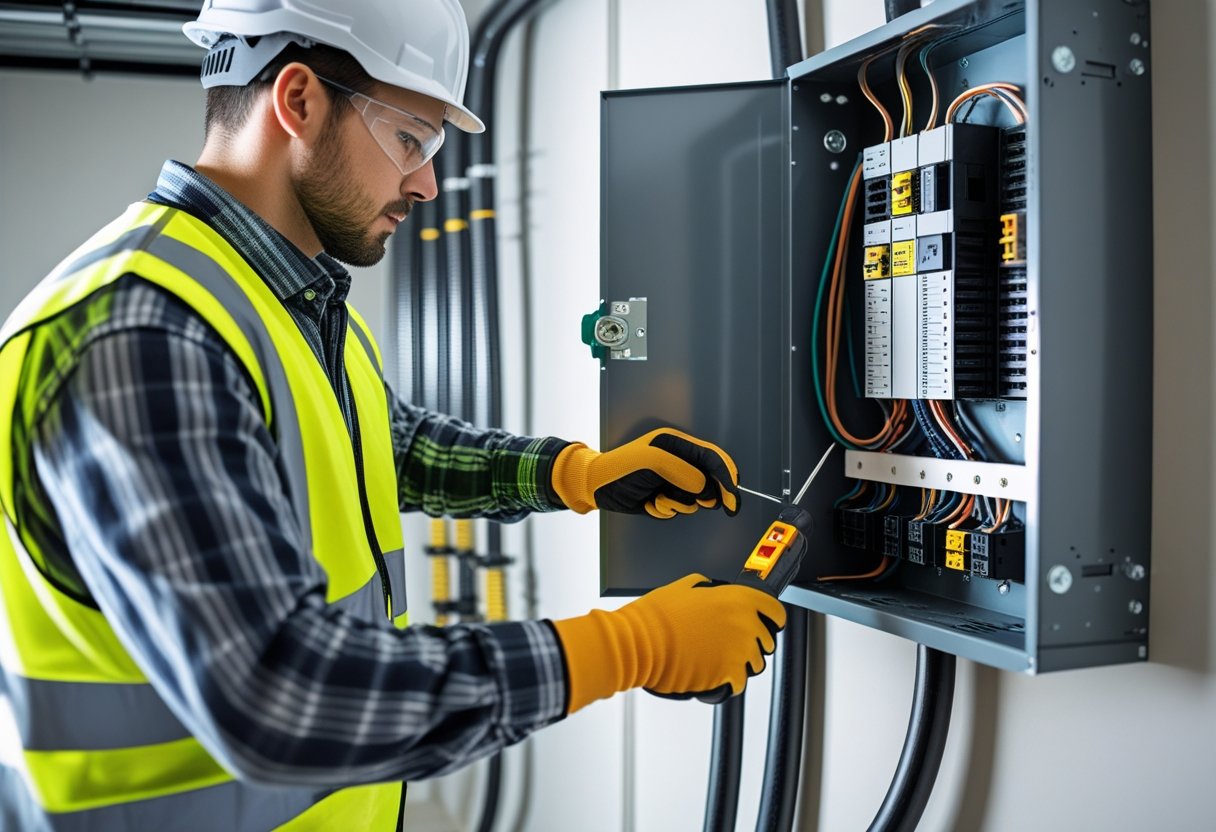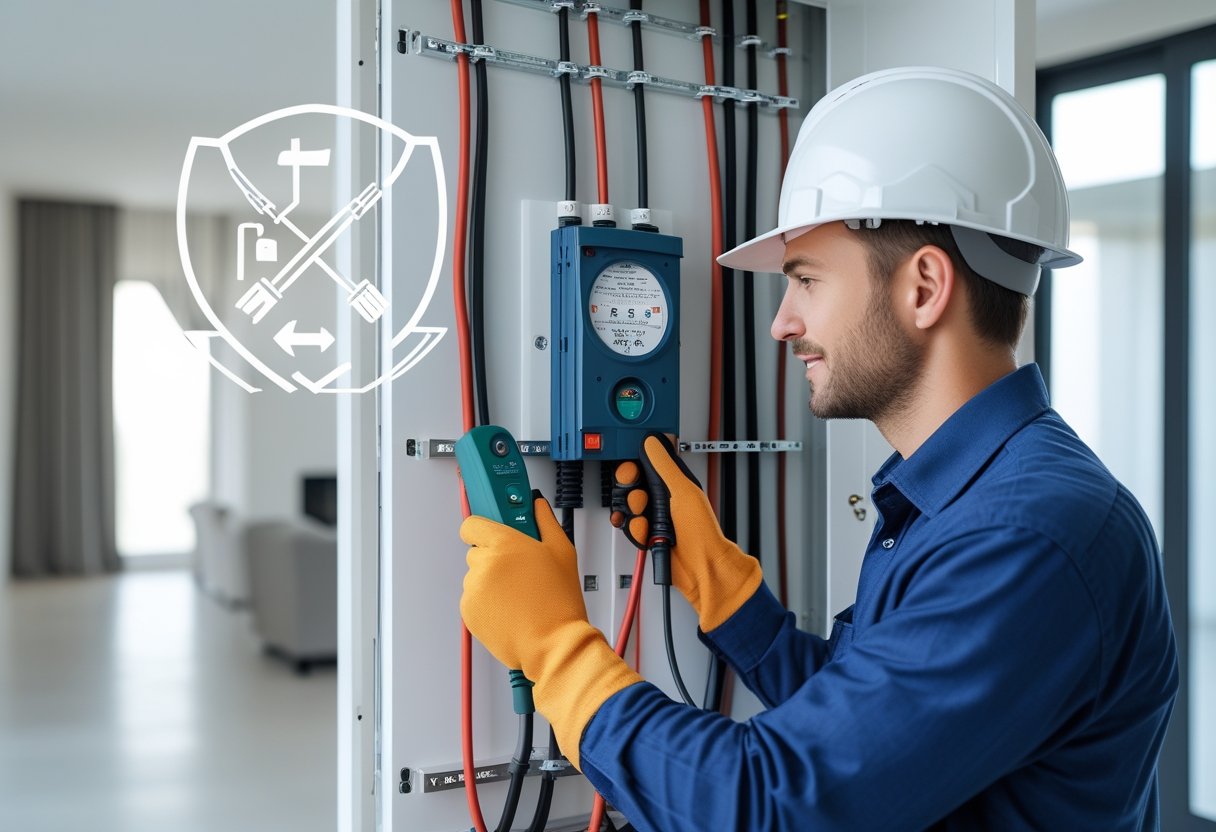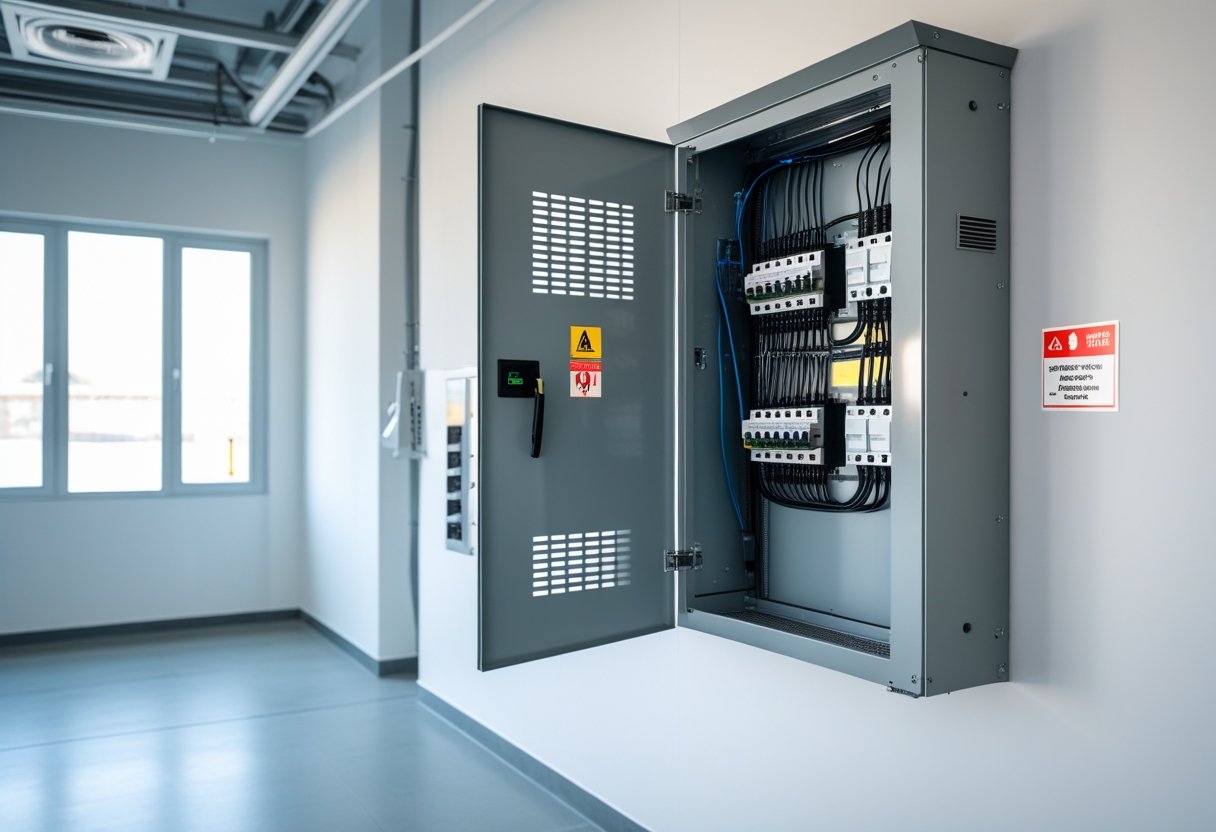If you’re thinking about electrical subpanel installation near you, find a licensed electrician who knows your local codes. A subpanel adds extra circuits and power to parts of your home without overloading your main panel.
It’s a smart way to avoid breaker trips and keep everything running smoothly.
Knowing what to expect and choosing a reliable service means your subpanel will be installed the right way. This protects your home and makes sure you have power where you need it most.
What Is an Electrical Subpanel?
An electrical subpanel is a smaller load center that connects to your main electrical panel. It helps you organize and control power distribution in different parts of your home or property.
Understanding how it works and its types can help you decide if you need one.
Primary Functions of a Subpanel
A subpanel extends the power capacity of your electrical system. It allows you to add more circuits without overloading your main panel.
This is useful when you add new rooms, appliances, or equipment. You can install a subpanel closer to the area where you need power, which reduces the length of wiring runs.
It also helps isolate electrical problems, making them easier to find and fix. Subpanels increase safety by managing electrical loads in a controlled way.
Types of Electrical Subpanels
Subpanels come in a few types based on size and use. The most common are residential subpanels, designed to support household circuits like lighting, outlets, and small appliances.
There are also commercial subpanels that handle heavier loads and larger operations. These often include special breakers for equipment requiring higher amperage.
You can find subpanels with different amperage ratings, usually from 60 amps to 200 amps. The size depends on how much extra power you need and the total load of your home.
Differences Between Main Panels and Subpanels
The main panel is the central hub for your electrical system. It connects directly to the utility's power supply and contains the main breaker that controls power to your entire home.
A subpanel is fed from the main panel through a breaker and controls power to a specific area. It doesn’t have a main breaker but has its own breakers for individual circuits.
Main panels handle the entire home's power needs. Subpanels help distribute it more efficiently.
This setup allows for better organization and makes future electrical upgrades easier.
Benefits of Installing a Subpanel
Adding a subpanel to your home’s electrical system gives you more control and space for electricity. It helps manage power better and makes your wiring neater.
You can add new circuits easily as your needs grow.
Enhanced Electrical Capacity
A subpanel increases the amount of electricity you can safely use at once. If your main panel is full or outdated, a subpanel lets you add more circuits without the cost of a full panel upgrade.
This is helpful if you have many devices or appliances. You avoid overloading your main panel, which can cause breakers to trip or create hazards.
By spreading power through a subpanel, you keep your system balanced. It also makes it easier to control circuits in specific areas like a garage, workshop, or new addition.
Improved Safety and Organization
With a subpanel, your electrical system becomes better organized. You can separate circuits by location or use.
This lets you shut off power in one area without affecting the whole house. It reduces confusion during repairs or upgrades.
You can quickly find and isolate problems. A subpanel also helps reduce wiring mess.
Instead of running many long wires back to the main panel, circuits go to a nearby subpanel. This lowers the chance of damage or mistakes.
Supporting Home Expansions
If you plan to add rooms, a home office, or outdoor equipment, a subpanel prepares your electrical system for the extra load. It gives you a place to plug in new circuits easily.
This flexibility protects your home's electrical safety and keeps your upgrades clean and efficient. A subpanel lets you grow your power system step-by-step.
When Do You Need a Subpanel?
A subpanel helps manage the electricity in different parts of your home more efficiently. You might need one if your current panel can’t handle extra circuits or if you want to keep your electrical system safe and organized.
Here are key reasons and signals that show you should consider installing a subpanel.
Common Situations for Installation
You often need a subpanel when adding new rooms, workshops, or large appliances that require their own circuits. For example, if you build a garage or home office, a subpanel nearby can handle all the new electrical demands.
It’s also useful if your main panel is full but you want to add more circuits. Instead of replacing the whole main panel, a subpanel lets you add power safely and affordably.
A subpanel can improve safety by separating circuits for heavy devices like EV chargers or HVAC units. This setup keeps your system balanced and reduces the risk of breaker trips.
Warning Signs You Need a Subpanel
Look for flickering lights or breakers that frequently trip. These often mean your main panel is overloaded.
If you see rust or corrosion inside your panel, that’s a sign it's aging and may need help from a subpanel. Another warning sign is double-tapped breakers—when two wires connect to one breaker.
This is usually unsafe and could mean your circuit layout needs updating. If your electrical panel is over 40 years old, it may not safely support modern power needs.
Adding a subpanel can help by taking on extra load and providing safer connections.
Future-Proofing Your Home
Planning for future electrical needs is smart. Installing a subpanel gives you space to add circuits as your family or technology grows.
It also helps keep your electrical system organized, making future upgrades easier and safer. You can isolate parts of your home, like workshops or new additions.
If you’re thinking about new appliances or electric vehicle chargers, a subpanel is a good way to handle the increased power demand. This can save money and avoid electrical hazards later on.
How to Find Reliable Electrical Subpanel Installation Near You
Finding the right professional to install your electrical subpanel means checking their experience, trustworthiness, and price. You want someone who understands local codes, has good feedback from other customers, and offers a fair quote.
Evaluating Local Electricians
Start by looking for electricians that specialize in subpanel installation. Focus on those with experience in handling panel upgrades or additions.
Ask about their previous work and how many subpanels they have installed. A skilled electrician will explain the process clearly and answer your questions.
You can also check if they provide on-site estimates to see how well they understand your home’s electrical needs.
Reading Customer Reviews
Checking reviews helps you learn about other people’s experiences. Look for patterns in the feedback like timely work, clean installs, or clear communication.
Be cautious of companies with many negative comments about delays, poor work, or unprofessional behavior. Reviews on sites like Google, Yelp, or local forums are often helpful.
Pay attention to how the company responds to complaints. It shows if they care about customers.
Checking Licensing and Insurance
A licensed electrician has passed tests showing they know the rules for safe electrical work. Always ask to see their license number or verify it with your state’s licensing board.
Insurance is just as important. It covers damage or injury that might happen during the job.
Without insurance, you could be liable for costs if something goes wrong. Don’t hire anyone who can’t provide proof of insurance.
Comparing Quotes
Get at least three quotes before deciding. Compare not just the price, but what’s included.
Look for:
- Labor costs
- Material quality
- Permit fees
- Estimated timeline
A very low bid might mean cutting corners or using cheaper parts. A detailed quote helps you avoid surprise costs and ensures you know what to expect.
Ask questions about anything unclear before choosing.
Subpanel Installation Process
Installing a subpanel involves careful preparation, choosing the right materials, and following a clear set of steps. You’ll need to know what to check first and gather essential tools.
Inspection and Planning
Before you start, inspect your main electrical panel and decide where the subpanel will go. Make sure your main panel has space and capacity to add a subpanel.
Check if your electrical system can handle the extra load safely. Measure distances between the main panel and the subpanel location.
This helps in buying the right length and type of wiring. Know local electrical codes and if you must get permits before work begins.
Turn off power to avoid shocks while working. You might want a licensed electrician to review your plans.
Materials and Tools Required
To install a subpanel, you will need several materials and tools. Materials include the subpanel, a circuit breaker for the main panel, feeder wires, and grounding wires.
Use wires with proper thickness to carry the load safely. You will also need tools like a screwdriver set, wire stripper, voltage tester, drill, and a wrench.
A conduit might be required if your wiring needs protection. A multimeter is useful to check voltage and make sure connections are correct.
Wear safety gear like gloves and goggles.
Step-by-Step Installation Overview
Turn off power at the main panel. Mount the subpanel box in the chosen spot.
Connect the feeder wires from the main panel's breaker to the subpanel’s lugs. Run grounding wires from the subpanel to your home’s grounding system.
Inside the subpanel, organize and connect neutral and ground bars separately. Install circuit breakers inside the subpanel for the circuits you want to add or extend.
Double-check all connections and secure all panels. Turn power back on and test the subpanel circuits with a voltage tester.
Safety Considerations for Subpanel Installation
When installing a subpanel, safety must be your top priority. This includes understanding the risks, knowing who should do the job, and making sure everything meets legal standards.
Common Safety Hazards
Working with electricity can be dangerous if you don’t handle it right. Common hazards during subpanel installation include electric shock, faulty wiring, and overloaded circuits.
If wires aren’t connected correctly, you could cause sparks or fires. Rust or corrosion on the panel can weaken the system, making it unsafe.
Double-tapped breakers, where multiple wires are attached to one breaker, create a fire risk and need fixing. Flickering lights or breakers that frequently trip are signs of trouble.
Avoid working near water or in damp areas. Proper grounding prevents electrical shock and equipment damage.
Why Hire a Licensed Electrician
Installing a subpanel isn’t a DIY job. A licensed electrician knows how to do it safely and follows all local rules.
They can assess your home’s power needs and make sure the new subpanel will handle the load. Electricians spot issues like outdated wiring or hidden damage.
Their work reduces the chance of fires and electrical shocks. Hiring a pro gives you peace of mind, knowing your electrical system is reliable.
They also carry insurance, so you’re protected if something goes wrong during the installation.
Compliance with Electrical Codes
Your subpanel must meet local and national electrical codes. These codes keep your system safe and efficient.
The panel must be properly sized and installed for your home's electrical demand. Inspectors check for correct breaker sizes, proper grounding, and safe wire connections.
If your subpanel fails inspection, you may need to redo some work. Hiring a licensed electrician helps you follow codes because they know the latest rules.
Following codes can prevent fines and safety hazards later.
Key Code Points to CheckWhy It Matters Correct panel ratingPrevents overloadsProper breaker installationAvoids electrical faultsGrounding and bondingReduces shock riskWire size matching breaker sizeEnsures safe current flow
Cost Factors for Electrical Subpanel Installation
When you plan to install an electrical subpanel, the total cost depends on several main factors. Knowing these details helps you prepare your budget and make decisions.
Average Price Ranges
Installing an electrical subpanel usually costs between $500 and $1,500. Basic installations, where electricians add a subpanel near the main panel with minimal wiring, cost less.
Complex jobs, like running long cables or upgrading your main panel, increase the price. Labor often makes up a large part of the cost, usually between $100 and $500 depending on your location.
Materials like the subpanel, breakers, and wiring add several hundred dollars more. Permits and inspection fees may also apply.
What Influences Installation Costs
Several things can change how much your subpanel installation costs. Distance from the main panel to the subpanel matters.
Longer cable runs need more materials and labor. The size of the subpanel also affects the price.
If you need a bigger panel for more circuits, the cost goes up. You might need to upgrade your main panel if it can’t handle the extra load.
This adds to materials and labor costs. Local permit fees and building codes can increase expenses.
A licensed electrician will check these details for you.
Ways to Save on Your Project
You can keep your costs down with a few steps. Choose a subpanel size that fits your current needs.
Avoid oversizing, which increases material and installation costs. Clear a direct path for wiring before the electrician arrives to reduce labor time.
Ask for multiple quotes from electricians to find a fair price. Check for any local rebates or incentives, especially if you’re adding circuits for energy-efficient appliances or EV chargers.
Maintaining Your Electrical Subpanel
Taking care of your electrical subpanel keeps your home's electrical system safe and running smoothly. You need to do basic maintenance, spot common problems, and know when to call a professional.
Routine Maintenance Tips
Turn off the main power before working on your subpanel. Check for loose wires or connections, as these can cause sparks or overheating.
Use a flashlight to look inside for dust, moisture, or corrosion. Keep the area around the subpanel clean and dry.
Avoid storing items too close to it so heat can escape and air can flow. Label all breakers clearly to help you identify circuits quickly.
Periodically test breakers by flipping them off and on. This helps ensure they don’t get stuck or fail.
If any breaker feels hot or looks damaged, call an electrician.
Troubleshooting Common Issues
If your breakers keep tripping, the panel might be overloaded or a specific circuit has a problem. Check which breaker trips often and what devices connect to that circuit.
Burning smells near your panel or warm outlets signal a dangerous issue. Watch for flickering lights or outlets with no power.
You can sometimes reset a tripped breaker by switching it fully off and then on. If the breaker trips again quickly, stop using it and call a professional.
When to Schedule an Inspection
Schedule an inspection if you see damage like scorch marks or rust on your subpanel. Also call for an inspection after major electrical upgrades or if your home has an old panel.
If your breaker trips often, you smell burning, or you notice flickering lights, call an electrician. These signs can mean serious safety hazards.
An expert will check wiring, breaker function, and code compliance.
Contacting Local Experts for Subpanel Services
When you need to install an electrical subpanel, contact local experts. Licensed electricians have the right tools and knowledge to do the job safely and by code.
Before you call, make a list of your needs. For example:
- Where do you want the subpanel?
- How much power will it handle?
- What devices or rooms will it serve?
Here’s what to expect from professionals:
- A clear quote covering labor, parts, and permits
- An inspection of your current electrical system
- Safe, neat installation and testing of the subpanel
If you have urgent electrical issues, some electricians offer emergency services. This helps if your existing panel is failing and needs quick attention.
You can find local services by searching online or checking reviews. Ask for references and verify licenses before choosing.
A proper installation makes your home safer and gives you room to add more circuits later.
Frequently Asked Questions
Installing an electrical subpanel means following rules, safety steps, and picking the right spot. Costs vary depending on parts and labor.
Keeping the subpanel in good shape requires regular checks and knowing when to replace it.
What permits do I need for installing a new electrical subpanel?
You need a permit from your local building department. This ensures the work meets safety codes.
A licensed electrician usually handles the permit and inspection for you.
Can you walk me through the steps of the installation process?
First, turn off the main power for safety. Mount the subpanel in your chosen location.
Connect wiring from your main panel to the subpanel. Install breakers and test the system.
What are the common safety concerns when installing an electrical subpanel?
Electrical shock is a top concern, so keep power off during work. Incorrect wiring can cause shorts or fires.
Make sure the panel is grounded and meets current codes.
How do I choose the right location for a new subpanel in my home?
Pick a dry, easy-to-reach spot with enough space around it. Avoid areas with heat, moisture, or heavy traffic.
The location should allow easy wiring from your main panel.
What factors determine the cost of installing an electrical subpanel?
Costs depend on the panel size, material quality, and wiring complexity. Labor charges and permit fees also affect the final price.
More circuits or breakers mean higher costs.
How often should an electrical subpanel be inspected or replaced?
You should have your subpanel inspected every few years. Schedule an inspection if you notice issues like frequent breaker trips.
Replace the subpanel if you see damage, signs of overheating, or if it no longer meets your home’s power needs.





